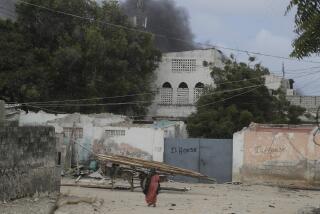U.S. Raid Nets 4 Somalis as Mogadishu Awaits ‘Big One’ : Africa: Jittery residents fear it was a trial run for a major U.N. reprisal for ambush that killed 4 GIs.
- Share via
MOGADISHU, Somalia — With loudspeakers blaring and weapons drawn in a pre-dawn raid that jolted this jittery city awake on Sunday, more than 300 U.S. soldiers in full combat gear fired tear-gas and concussion grenades into a small block of homes in southern Mogadishu, injuring no one but taking four Somalis prisoner.
Officially, it was billed as a routine “cordon-and-search” weapons sweep by the multinational U.N. peacemaking force attempting to disarm and rebuild Somalia--notable, perhaps, only for the large force deployed, U.N. military spokesman Maj. David Stockwell said.
But as news of the raid spread through Mogadishu even before the sun rose Sunday, residents of this war-ravaged city instantly reached a conclusion of their own:
The raid was a trial run, a rehearsal for “the big one.”
Such is life in a nation anxiously awaiting retaliation, a much-expected U.N. counterstrike to punish the Somali clan believed to be responsible for last Sunday’s lethal ambush of a U.N. patrol.
In fact, every day since the remote-controlled land mine killed four U.S. soldiers--the largest single loss of American lives since U.S. troops arrived in Somalia last December--the capital’s residents have braced for the worst--”just waiting,” as one put it, “for the other shoe to drop from the sky.”
So it happened two months ago, when the massacre of 24 Pakistani peacekeepers by Somali gunmen brought the United Nations’ military wrath. After seven days of talking and waiting, a squadron of U.S. AC-130 Spectre gunships answered the June 5 attack by attacking four arsenals and a radio station owned by the warlord blamed for the attack, Mohammed Farah Aidid.
Again last month, the United Nations ordered U.S. Cobra attack helicopters to assault a Mogadishu villa it identified as Aidid’s command-and-control center, which the renegade warlord allegedly used to evade capture and coordinate a continuing hit-and-run terror campaign against U.N. troops throughout the city. The United Nations said the July 12 raid killed more than a dozen of Aidid’s top military advisers, although the Red Cross reported as many as 54 civilian casualties.
Now, the U.N. secretary general’s special representative in Somalia, retired U.S. Adm. Jonathan Howe, has added last Sunday’s attack on the U.S. soldiers to the list of Aidid’s crimes. And with the former Somali general still reportedly in hiding somewhere in Mogadishu, many expect a U.N. counterattack at any moment.
“At night, when you go to sleep, you never know what it will be in the morning,” said Amina Haji Abdullahi, a prominent Somali intellectual who is a founding member of a national women’s group. “Just everyone is hiding, waiting, worrying.”
“The people are just confused and tired of being scared,” added Ahmed Hussein Fidow, a former Somali Airlines pilot who worked briefly for the United Nations here. “We expect the Americans will retaliate, but when, where, how? That is all the people are talking about.”
In a weekend interview, Howe, who is in charge of all U.N. civilian and military operations in the country, told The Times: “We’re not anxious to use military force. We think it should be used in a very careful, responsible way, in a way that minimizes losses to civilians and innocents.
“But we’re not hesitant to use it where it makes sense.”
Such ambiguity has stoked anxiety on Mogadishu’s streets.
Sunday’s theory that the raid by a full one-fourth of the U.S. Army’s 1,200-member Quick Reaction Force in Somalia actually was a rehearsal for a future operation to get Aidid was just the latest.
Just 12 hours earlier, the United Nations closed Mogadishu’s international airport for nearly an hour while a dozen U.S. attack helicopters went through a series of complex aerial maneuvers.
At a Saturday evening briefing, U.S. Army Col. Mike Dallas, commander of the Quick Reaction Force, which includes the helicopters, said only that the aerial display had been a training exercise that he could not explain further because “it might get into the area of future operations.”
The instant theory on the streets of Mogadishu: The Americans are planning an airborne “hot extraction operation”--braving gunfire to seize Aidid from his hiding place.
“It’s easy to understand how these rumors start and spread,” said one U.N. official, a veteran of the aid mission in Somalia who asked not to be identified by name. “Since June 5, the people here have seen a pattern develop of attack and counterattack. And, after years of war that has killed hundreds of thousands and torn the country to bits, they’ve learned to be suspicious of everything that happens around them.”
More to Read
Sign up for Essential California
The most important California stories and recommendations in your inbox every morning.
You may occasionally receive promotional content from the Los Angeles Times.












